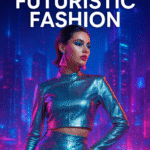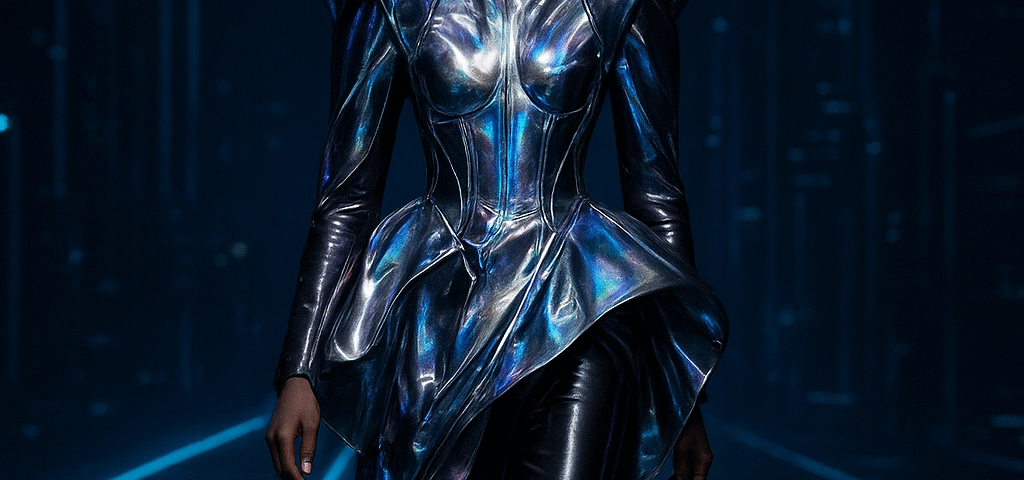
Unveiling Tomorrow: The Clear Appeal of Transparent Futuristic Fashion
November 3, 2025
Retro Futuristic Fashion: A Style from Tomorrow’s Past
November 4, 2025Fashion is often a reflection of its time, but some designers choose to look far beyond the present. They don’t just create clothes; they build worlds, challenge perceptions, and sculpt new realities from fabric and technology. This is the realm of avant-garde futuristic fashion, a creative space where the boundaries of clothing are torn down and reassembled into something entirely new. It is a bold, experimental, and often shocking exploration of what humanity could wear in a world yet to come.
This article ventures into the exciting domain of avant-garde futuristic fashion. We will explore what defines this boundary-pushing movement, the innovative designers leading the charge, and the groundbreaking materials that make their visions possible. Prepare to see fashion not just as attire, but as art, prophecy, and a statement on the future of human identity.
What is Avant-Garde Futuristic Fashion?
Avant-garde futuristic fashion is a subgenre of design that merges experimental, often radical, artistic expression with forward-looking concepts. The term “avant-garde” itself means “advance guard,” referring to artists or works that are experimental and unorthodox. When paired with “futuristic,” it describes fashion that is not just ahead of its time, but actively imagines a different time altogether.
Unlike mainstream futuristic trends that might focus on sleek metallics or clean lines, this style is characterized by:
- Deconstruction and Reconstruction: Garments are often taken apart and put back together in unconventional ways, challenging the very idea of how clothes should be constructed.
- Exaggerated Silhouettes: Designers play with volume, proportion, and form to create shapes that defy the natural lines of the human body.
- Unconventional Materials: Anything from 3D-printed polymers and lab-grown textiles to scrap metal and electronic components can be used.
- Conceptual Storytelling: Each piece or collection often tells a story or explores a complex theme, such as post-humanism, ecological crisis, or the fusion of biology and technology.
This style is less about wearability in a conventional sense and more about making a powerful artistic and intellectual statement. It is fashion as a thought experiment.
The Visionaries: Designers Shaping the Future
The world of avant-garde futuristic fashion is driven by a handful of visionary designers who consistently challenge our expectations. Their work is often seen in museums and on couture runways, serving as a wellspring of inspiration for the entire industry.
Iris van Herpen
Perhaps the most recognized name in this field, Dutch designer Iris van Herpen is celebrated for her seamless fusion of technology and traditional craftsmanship. She collaborates with scientists, architects, and programmers to create breathtaking garments using techniques like 3D printing, laser cutting, and magnetic manipulation. Her collections explore natural phenomena like cymatics (the visualization of sound) and the intricate patterns of synthetic biology, resulting in pieces that appear to be living sculptures.
Rei Kawakubo
As the founder of Comme des Garçons, Rei Kawakubo has been a leading figure in the avant-garde for decades. Her work often questions conventional standards of beauty and the very function of clothing. Her famous 1997 collection, “Body Meets Dress, Dress Meets Body,” featured garments with lumps and bumps in unusual places, radically altering the human silhouette. Her approach to avant-garde futuristic fashion is more abstract, focusing on form and the philosophical relationship between the body and the garment.
Rick Owens
Known for his “glunge” aesthetic (a mix of glamour and grunge), Rick Owens presents a darker, more primal vision of the future. His designs often feature dramatic draping, monastic silhouettes, and a palette of black, white, and earth tones. While his work is more commercially viable than some of his peers, his runway shows are pure performance art, exploring themes of ritual, decay, and survival in a dystopian world.
The Materials of Tomorrow, Today
The radical visions of avant-garde futuristic fashion would be impossible without a constant stream of material innovation. These designers are often pioneers, using and sometimes even inventing new textiles and substances to bring their concepts to life.
3D-Printed Polymers
3D printing has revolutionized the field, allowing designers to create complex, rigid structures that would be impossible to achieve with traditional sewing. Iris van Herpen, in particular, has used this technology to craft intricate, lattice-like dresses and exoskeletal accessories. These polymers can be customized for flexibility, color, and texture, opening a new frontier for bespoke, sculptural fashion.
Lab-Grown and Bio-Integrated Textiles
The intersection of fashion and biotechnology is one of the most exciting areas of development. Designers are experimenting with materials grown in a lab, such as synthetic spider silk and leather cultivated from mushroom mycelium. Some projects even explore “living” textiles embedded with microorganisms that can photosynthesize or purify the air. This represents a shift towards a truly symbiotic relationship between our clothing and the environment.
Smart Fabrics and Wearable Tech
While wearable tech often brings smartwatches to mind, the avant-garde application is far more integrated. This includes fabrics with embedded fiber optics that can change color or display patterns, garments with sensors that react to the wearer’s biometrics (like heart rate or body temperature), and clothing that can generate its own energy through movement. In this context, technology is not an add-on; it is woven into the very fabric of the garment.
The Cultural Impact of Pushing Boundaries
You may never wear a 3D-printed dress that looks like a splash of water, but the influence of avant-garde futuristic fashion is more significant than you might think. These radical experiments on the runway serve several crucial functions:
- Driving Innovation: By pushing materials and techniques to their limits, these designers inspire textile manufacturers and tech companies to develop new products.
- Expanding Our Definition of Beauty: Avant-garde designs challenge our often-narrow standards of what is considered beautiful or fashionable, promoting a more inclusive and creative perspective.
- Acting as a Social Commentary: This fashion can be a powerful medium for commenting on social, political, and environmental issues. A collection made from ocean plastic or designed to look like a biological mutation forces the viewer to confront uncomfortable truths about our world.
Ultimately, the creations of the avant-garde trickle down. An exaggerated silhouette on a couture runway might be softened into a bold shoulder on a high-street blazer a few seasons later. The experimental becomes the aspirational, and eventually, the normal.
Final Words
Avant-garde futuristic fashion is a vital and exhilarating part of the fashion ecosystem. It is a laboratory where the wildest ideas are tested and the future is sketched out, one stitch, one print, and one circuit at a time. It reminds us that clothing can be more than just a covering; it can be a question, a statement, and a piece of art.
While these designs may seem distant from our daily lives, they are the engines of change, pushing the entire industry forward. They challenge convention, inspire innovation, and offer a spectacular, thought-provoking glimpse into the endless possibilities of what we might one day wear. The future of fashion is being built in these experimental spaces, and it promises to be anything but ordinary.
Frequently Asked Questions (FAQs)
Q1: Is avant-garde futuristic fashion meant to be worn in everyday life?
A: Generally, no. Most avant-garde pieces created for runway shows are considered conceptual art. They are designed to express an idea or showcase a new technique rather than for practical, daily wear. However, more accessible, ready-to-wear lines from these designers often translate the core concepts into wearable garments.
Q2: How is this different from cosplay or costume design?
A: While there can be aesthetic overlap, the intent is different. Cosplay and costume design aim to replicate a specific character or look from an existing fictional universe. Avant-garde futuristic fashion is about creating something entirely new and original to explore a concept, emotion, or a potential future.
Q3: Are these experimental fashions sustainable?
A: They increasingly are. Many leaders in the avant-garde futuristic fashion movement are also pioneers in sustainability. They are often the first to experiment with eco-friendly innovations like bio-plastics, lab-grown leather, and recycled materials. Their work highlights that a forward-thinking vision must include environmental responsibility.
Q4: Can I buy avant-garde futuristic fashion pieces?
A: The most extreme couture pieces are often one-of-a-kind and sold to collectors or museums. However, many of these designers have more accessible (though still high-end) ready-to-wear collections available at luxury retailers. You can also find emerging designers with a similar aesthetic on platforms like Etsy or at specialized boutiques.
Q5: Why is avant-garde fashion so important if most people don’t wear it?
A: It serves as the research and development department for the entire fashion industry. The experimentation with new silhouettes, materials, and construction techniques on the avant-garde stage eventually influences mainstream trends. It keeps fashion dynamic, innovative, and culturally relevant as an art form.



